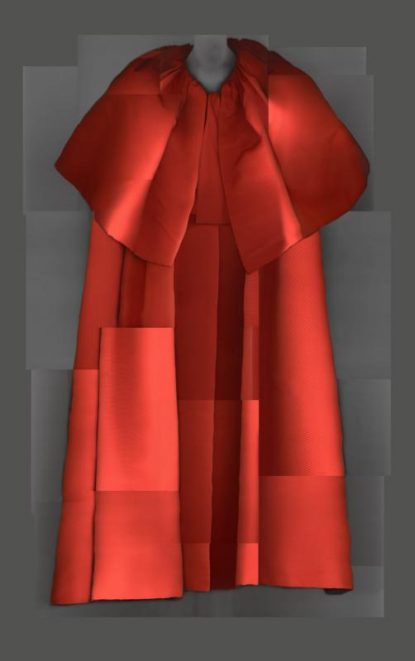
This digital composite scan of “Evening Coat, Cristobal Balenciaga for House of Balenciaga” 1954-55 is part of the Metropolitan Museum of Art’s exhibit “Heavenly Bodies: Fashion and the Catholic Imagination,” which debuts May 10 in New York City. (CNS photo/courtesy Metropolitan Museum of Art, Digital Composite Scan by Katerina Jebb)
The following editorial was published online June 6 by Extension magazine, a quarterly publication of Catholic Extension, a Chicago-based organization that raises and distributes funds to support U.S. mission dioceses. It was written by Elizabeth Boo, editor.
***
The new exhibit, “Heavenly Bodies: Fashion and the Catholic Imagination,” at the Metropolitan Museum of Art in New York City shows that the beauty of the Catholic Church inspires fashion. The rich colors, fine fabrics and sparkly brocades translate into exquisite fashion. The beautiful church sparks the imaginations of designers and fashionistas to create.
Who else does it inspire?
People who live in poverty.
People who are trying to create a better life but face enormous barriers. Moving out of poverty — or at least managing its implications — is an arduous road. To do so takes great imagination. Imagining the steps needed to build a stronger life. Imagining that you are more than your circumstances.
For people with limited means, a Catholic church is a special place of inspiration. It’s where they meet others facing similar challenges who give them ideas or lend a hand. It’s where they find ministries for basic needs, kind words and a sense of dignity and purpose.
It’s a place of beauty. Not opulent beauty, but simple, elegant beauty. Beauty that stirs the imagination. Beauty that transcends the vagaries of everyday life and whispers, “You are not alone.”
[hotblock]
People in poverty, especially those in rural and remote areas, are not surrounded by museums and life’s fineries. Their areas are rugged, and their homes are modest. At church, they see beauty that makes them believe they are part of something bigger — a thought they don’t come by easily in the daily grind.
We all need awe. It’s not just that exhilarating, fleeting moment, when the world stops for a second. Those moments change our next steps. They change us. They make us see differently.
In rural Malakoff, Texas, Mary Queen of Heaven Catholic Church was recently rebuilt. It had been a metal building that was refurbished from a leather factory in 2006 — functional but not inspiring. After a fire destroyed it, parishioners set off to rebuild. In an impoverished area, they wanted beautiful. They repurposed pieces from the old church, created stained-glass windows and found funds to commission a painting of Mother Mary for over the altar.
Sally Keenan, a parishioner, said, “Humans long for beauty and transcendence. Especially in areas that struggle, beauty speaks to the inner self and impacts the whole community.” She donates beautiful vestments to new priests who come to the area. “When a priest dresses for Mass, he dresses for Christ. He needs to put on the best,” she said.
In Pikeville, Kentucky, St. Francis of Assisi Catholic Church was reconstructed in 2015. Located in Appalachia, where Catholics are rare, the small parish had outgrown its previous church, which was old and crumbling. For a new church, Father Richard Watson, the pastor, wanted it humble in the tradition of St. Francis but to feel like a house of God. His parishioners were deserving. “When the outside world fails them and refuses them hope,” he said, “the simple beauty of a church gives them the opportunity to transcend this world and experience God.”
[hotblock2]
Or in the deep south of Georgia, when Father Fredy Angel, a Colombian-born missionary, brought together three dispersed faith communities to construct one multicultural church, he had beauty in mind. “Our church needs to reflect heaven. It must bring you to a higher level, to God,” he said. “Our parishioners wear their best clothes to church. They feel good here. It changes their self-esteem.” In Ray City, where 30 percent of residents are below the poverty line, St. Anthony of Padua Catholic Church is a slice of heaven.
At this moment, the fashion world looks to the Catholic Church for inspiration. Next year, they’ll have new sources. But for those with few economic resources, the church is a continuous font. That is why churches matter in poor areas. They play a huge role in bringing people out of poverty.
Through the Metropolitan exhibit we are reminded that the church transforms individuals and cultures. But there is another reality. In poor regions across America, marginalized communities do not have churches nearby or their churches greatly need repair.
This needs attention.
People in tough circumstances need beauty — and the dreams it unleashes — to create a path forward.
***
The views or positions presented in this or any guest editorial are those of the individual publication and do not necessarily represent the views of CatholicPhilly.com, Catholic News Service or of the U.S. Conference of Catholic Bishops.
PREVIOUS: Catholic investing challenges us to examine our financial management
NEXT: Step up with tough love for one who needs it



Share this story